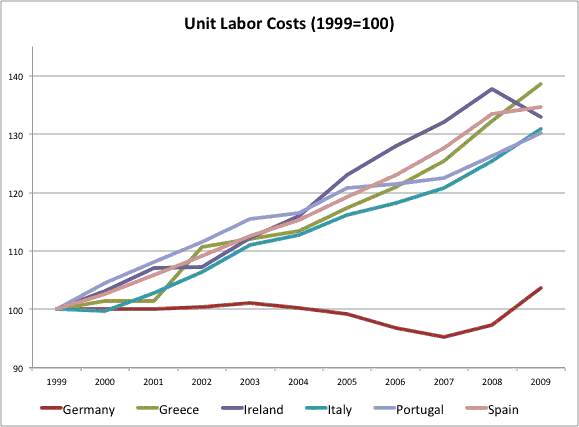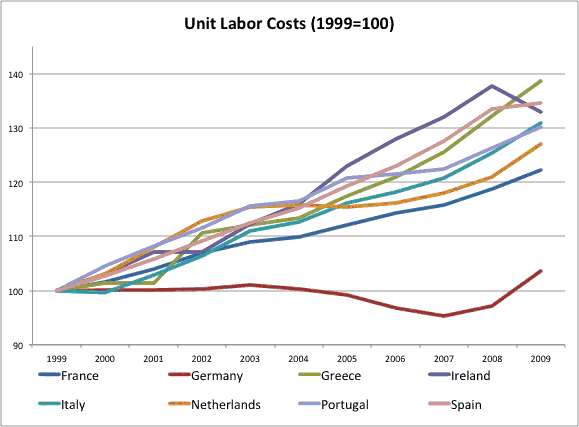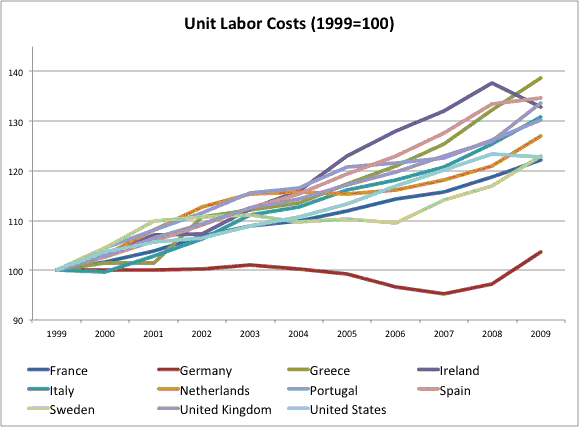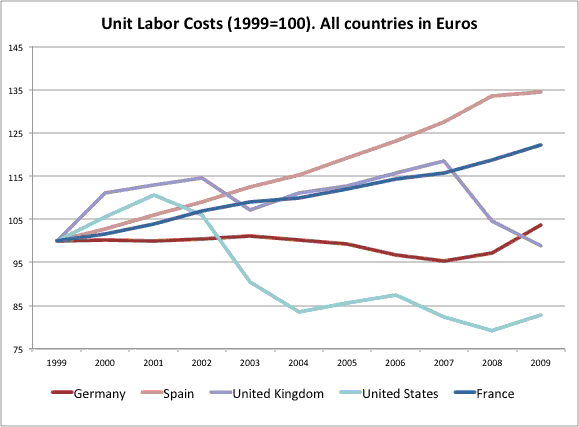The story of how the creation of the Euro has led to a large discrepancy in unit labor costs among members of the Euro area is often used to explain the large current account imbalances in these countries, which are partly responsible for the current crisis. These imbalances cannot be easily addressed because of the absence of national currencies. It all starts with a chart that looks like this one:

Data is from the OECD and it shows how Greece, Ireland, Italy, Portugal and Spain saw their labor costs increase relative to Germany since the creation of the Euro. This eroded their competitiveness and it is one of the reasons why we find ourselves in a crisis. I wrote last week about how including France in this picture would challenge the conclusion that it is all a problem of the club-med countries (plus Ireland). As I argued there, France looks a lot like all of those countries, Germany is the outlier.
I was curious to see what other countries looked like during those years. So I added the Netherlands and this what I now had:

There are some differences and the increase in unit labor cost was lower in the Netherlands and France than in the other two countries but the real message is the same as before: Germany is the outlier in this story.
So I was now curious to include other countries, those that are not part of the Euro area. Here is what happens if we now include Sweden, the UK and the US.

It is becoming very difficult to see which country is which with the exception of Germany! This picture makes it even more evident that the Euro effect on unit labor costs is very much driven by one country. And that comparing Germany to countries outside of the Euro area leads to the same conclusion.
The picture above is missing something: it is not correcting for movements in exchange rates, it is just looking at unit labor costs from a domestic perspective (measured in local currency). What happens if we convert the numbers for the US and the UK into Euros?

Now the story is very different for the UK and the US. In both cases their exchange rate has depreciated significantly. In the case of the US it is a trend that started in 2000 when he Euro reached its minimum (about 83 cents of a dollar). In the case of the UK, the pound retained its value relative to the Euro until the recent crisis when it collapsed. By 2009, and measured in Euros, the unit labor costs of the UK look similar to that of Germany. In the case of the US they look even lower because of the large depreciation of the dollar relative to the Euro since 2000. Let’s not forget that despite the fall in the US dollar, the current account of the US still had significant deficits during all those years.
What I learn from this analysis is that from a domestic point of view, ignoring exchange rates, what happened in Germany in terms of labor costs was very unique. No other country looks like Germany and whether we look at Southern Europe or Northern Europe or we go to the UK or the US we get a similar evolution of labor costs. When you add the exchange rate we find that in the case of the UK and the US, during these years the depreciation of their currencies have made the labor costs fall when measured in foreign currency. How sustainable is this trend is unclear. We have already seen the Euro falling relative to its peak but about 20% which has undone some of what we see in the picture above (the picture above finishes in 2009 when the Euro was higher in value than today).
- Bulenox: Get 45% to 91% OFF ... Use Discount Code: UNO
- Risk Our Money Not Yours | Get 50% to 90% OFF ... Use Discount Code: MMBVBKSM
Disclaimer: This page contains affiliate links. If you choose to make a purchase after clicking a link, we may receive a commission at no additional cost to you. Thank you for your support!



Leave a Reply